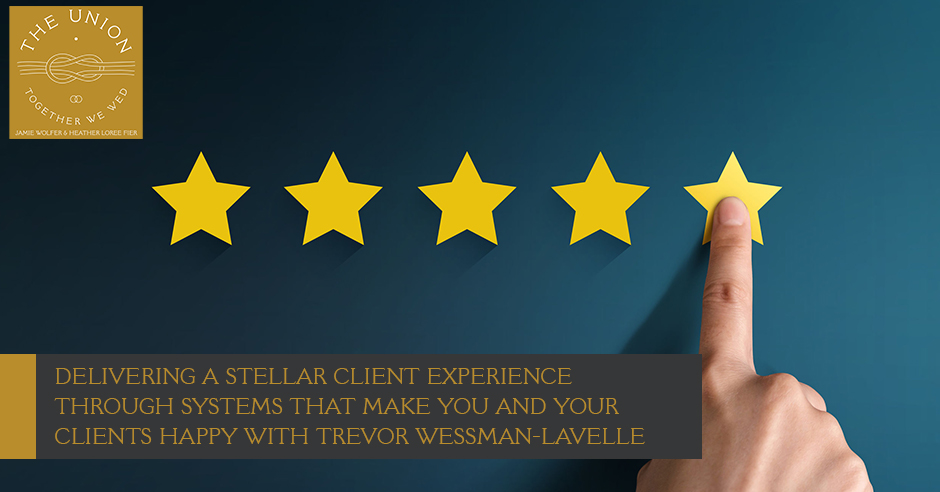
We live in an Amazon and Google world. Consumers expect immediate gratification, 24/7 support, and a polished online presence. Jamie Wolfer and Heather Loree Fier welcome Trevor Wessman-Lavelle from Aisle Planner to discuss the dramatic changes in client expectations over recent years. They dive into the realities of running a business in this 24/7/365 world, especially when you’re running as a solopreneur. Now more than ever, small businesses need smart systems to deliver a product or service that the clients of today love. Allow Trevor to help figure out how we can let tech work for us to create a fuller customer experience, set clear boundaries, and have a better overall quality of life. Sharpen your tech game to deliver a stellar client experience through this great conversation.
—
Listen to the podcast here:
Important Links:
About Trevor Wessman-Lavelle
 Vice President of Sale and Marketing, Aisle Planner
Vice President of Sale and Marketing, Aisle Planner
Working with a passionate, dedicated and entrepreneurial team to win hearts and revenue with smart, actionable and profitable strategies that connect, inspire and change our clients’ games.
Delivering A Stellar Client Experience Through Systems That Make You And Your Clients Happy With Trevor Wessman-Lavelle
Jamie: On the show, we have Trevor from Aisle Planner coming to join us. The main reason that we wanted him to join us is because many things are happening technology-wise in many different spaces. It can be difficult for us as wedding vendors to figure out how that translates into our lives because in an era of Amazon Prime and streaming TV at your fingertips, customers want what they want when they want it. It’s important for us to figure out how we can let tech work for us to create a fuller customer experience, help us set clear boundaries, and have a better overall quality of life. That’s a big statement and I’m sticking to it. Both Heather and I firmly believe that tech can do some incredible things for your business.
—
Heather: We are excited to have Trevor Wessman-Lavelle from Aisle Planner with us to talk about how times are a-changing and consumer expectations are on the rise. We, as wedding vendors, have to deliver on that experience. Trevor, thank you so much for being here.
Trevor: I am happy to be here with you.
Heather: We are glad you are here. You guys do a great job helping wedding vendors get organized with tech. You are the person who is going to open the curtain for us and help us learn how to sharpen our tech game and make sure we deliver on this crazy consumer experience people have. Can you start by talking a little bit about how the wedding industry pros are having to step up to this? People expect us all to run like Google. When you’re a one-woman show here, it can be a little tough to do that. What are your thoughts on the situation?
Trevor: It is tough. That’s a good way to put it. I often refer to Amazon myself simply because that’s an experience we all can relate to. In reality, that’s where our expectations are going. Consumer tech is what’s driving tech or at least that the predominant force that’s driving, where tech is going in terms of how it’s changing the way we do the simplest of things, picking up some laundry detergent for instance. It used to require either order in a catalog and waiting for somebody else to deliver it to your house or hopping in the car, going on down to the store, grabbing it, and bringing it back home. Now you just click a button and there it is.
It relates to how we connect with tech, not just what we’re doing on those tech platforms that we’re using but I also look at the mobile phone. We’re living most of our digital lives via a mobile device, a phone, a tablet, or even an app-enabled laptop. Those are training devices. When we think about it through the lens of a professional trying to relate to our customers, these devices are enabling companies to connect with the customers. They do what the customers want to do or that they want the customers to do from the palms of their hands. They’re simplifying processes.
Tech is learning more and learning more quickly about customers so that they can deliver upon those expectations to receive whatever product or service it is that they’re looking for as quickly and seamlessly as possible. On top of that, our tech empowering consumers to even buy more because of suggested purchases, like-buys or parent client reviews with products, so we feel more confident about the purchases that we make. As that translates to the solopreneur or the entrepreneurial-minded small business owner looking to make connections, it’s looking at not how tech can help your business do more things to make you more efficient but to deliver against those clients and lead expectations.
How quickly are you getting back to your lead? How quickly are you creating or delivering your brochure that outlines all of your packages and products? How quickly are you getting that proposal over to them? Is that proposal even interactive that you have that layering built into it? Of course, the important factor to a successful business is booking that volume that you need to sustain and operate throughout the year. How quickly are you able to transact that process and convince your client that you are the right partner for them in creating their event?
Heather: Having the systems down where all of that is done efficiently is important. I know my clients generally don’t think of the fact that they are paying me not just for my hours I’m at their wedding or working on their wedding. They’re also having to pay me for the time it took to acquire them as a client to market to them. All of that is important. All of that which the couples aren’t considering is added in here. For couples having a good, smooth experience with your vendor from the beginning shows you that this person has things in an efficient process that’s going to optimize the money you’re spending. To me, that’s good for everybody. The only downside I see on this is working with text sometimes is hard, overwhelming and confusing. When you are a one-woman show or one-man show, how do you know you’re getting the right tech that’s going to be simple to get started and solve the problem for you to not to make it more complicated.
It is the job of tech companies to make our products more intuitive and easier to learn and operate. Click To TweetTrevor: I’m going to throw this back to the pros and with a question that they’re going to ask themselves. That is, “What is your goal?” Ultimately, we all want to take on the world. We all want to solve all of our problems in one fell swoop or at least that’s the solution that we’re looking for on a day-to-day basis. Frankly, we should know and we should accept that there is no end-all-be-all solution. It is the job of tech companies to make our products more intuitive and easier to learn and operate. At the end of the day, the question the pros have to answer is, “This year, this month or over the next six months, I want to do this for my business. This is my goal. It’s realistic and it’s achievable.”
Identify the best solution. You got to do your homework, look at a couple of different platforms, do those free trials, engage those companies, do the demos, and then find the right platform that’s going to work for you. At the end of the day, you have to invest in adapting. I get it. I know it’s hard. I had to learn HTML coding in fifteen minutes when I started working here. I wouldn’t say that I’ve learned it. That’s, probably a little more than what I’ve done. I do a lot of copying and pasting but the reality is that I’ve had to learn that in order to adapt to the world of tech.
Frankly, if you’re not willing to invest the time to work on your business as much as you work in it, I hate to say this to you, but your path to success is probably going to be fraught with lots of painful turns and setbacks. We know that the future of business, in general, in connecting with consumers, booking them and managing their business, no matter what it is that they’re looking for, it’s going to be driven by tech. Even if the transaction part of it happens face-to-face in person, it’s starting with tech. If you cannot start with tech in your business and make the investment to enable yourself to do so, I don’t know what else to tell you.
Heather: Jamie, what are your thoughts on that about systems being so critical in a business?
Jamie: There’s a statement that you make, Trevor, about working on your business as much as you are working in your business. That’s such a powerful statement. Many of us learn the hard way and many people who are venturing into their own business don’t realize that it’s not just planning weddings for me. It’s figuring out streamlining my email communication. It’s figuring out putting together the perfect brochure that has the exact right words in it to get the point across quickly. That one hit me hard like, “You’re right,” because I didn’t see that when I started. I was like, “I’m going to plan weddings and they’re going to be pretty.”
I did not realize how long it would take me to find the right system and to get everything into place. Probably the first two years of my business, I was like, “I don’t know what I’m doing.” I probably still don’t. I’m just faking it much better. I’ve learned firsthand and I learned the hard way how important and how critical having a good system is in places because if you don’t have that, then you’re just floundering in the water. You’re spending so much time working on your business and less time in it because there’s so much to figure out.
Trevor: One of the things that I love to look at every day when I get in my car is that little sticker in the top left corner that shows you when your next oil change is due. From a business standpoint, a perfect metaphor for best practice is having that little reminder to say, “I need to check in on how my business is operating in the next 3,000 miles or in the next 30 days,” or “If I want to do this in order for my car to run for the next 3,000, 5,000 or 10,000 miles, I know that I need to check in on it in the most base sense, by the state or by this mileage, and translate to date that can translate to project count that can translate to gross income.”
Maybe these are things that are not top of mind for some pros, but they probably should be if they want to be running successful businesses. “I need to check in on that,” and that’s a good thing. That means that you’re going to run the next 3,000, 5,000 or 10,000 miles or an hour, in our case, dollars. You’re going to be able to book that next event. You’re going to be able to go to that next trade show or workshop and be able to afford it. You’re going to be able to maybe grow our business by adding on some team members or by increasing your pricing.
Jamie: Being inspired by an oil change sticker. You’ll never know.

Delivering Client Experience: Consumer tech is the predominant force that’s driving where tech is going in terms of how it’s changing the way we do the simplest of things.
Heather: You cannot scale without the right systems. I can say that from experience running a company that grew to a national scale. It was integral to have those systems dialed in because things go off the rails fast when you have other people working under you, within your system and within the company. You’re not driving anymore. Other people are handling it for you so if you don’t have that oil change sticker there, they’re not going to go do the oil change. You need to set those boundaries for them for sure.
Trevor: It’s a great segue if we want to stay in the automotive analogies. We’re not driving a single person car. We’re not operating a business that only we can fit into. Everybody needs to fit into this, including our clients. We want to be driving the bus and we want a bus full of clients. We want a bus full of trusted vendor partners and team members. At the end of the day, we have to set those boundaries. We have to determine, what is it that we’re offering? What kind of ride that we’re giving those clients if we’re talking about clients, specifically? Is this a nice and comfy cruiser? Is this a sporty little roadster? In terms of developing those systems and then choosing the software platforms and tech platforms that you’re using to deploy those systems. It comes down to how you’re informing the experience and what kind of boundaries you can set for your clients. What kind of ride can they expect from you?
Heather: What bus route you’re going on, that’s what we want to know. Are you going to take them to the coastal route or inland? Where are you taking them?
Jamie: This technology is going places, so we could do this the whole episode. Speaking of boundaries, because that’s a nice little segue, a challenge for vendors is setting boundaries with their clients with things like social media email, cell phones, text messaging, and phone calls. Clients can feel like they should get free access to their vendors and that can be daunting. Trevor, how can smart tech help vendors set boundaries?
Trevor: By having a place for vendors to go. That’s unfortunate for professionals but it’s also the unfortunate thing for a lot of tech companies because at least on the B2B side, tech companies are offering linear solutions. They do a thing for you or maybe they do a few things for your business, but the approach that we want or we advocate for amongst the professional community is, what experience are you looking to deliver to your clients? The ones that not only deliver the best experience are the ones that also deliver the best experience through the entire project management process or the client relationship that connect the client to the process itself. It’s not just a portal by which information or documents are delivered, but it houses the process and project itself.
That’s why Aisle Planner specifically, we have permission settings for the clients in addition to team members and vendor partners that you can customize. In this day and age, consumers have access to anything and everything that they could possibly imagine wanting at the push of a button at any hour, minute, second of every day. We, as humans, especially humans running small businesses, whether they’re solo doing it all on their own or they’ve got even a medium-sized team and a large team, we’re not working 24/7. That’s not what humans do. That is what some tech does. Some companies do utilize 24/7 availability, but not so much in this space. What can you provide? You can provide access to information and available 24/7, 365. That enables you by providing this centralized location for anything related to their event, which they’re investing a great sum of money. Weddings are by far one of the biggest investments that a person will make in their lives, on themselves specifically.
We can put college or kids aside because we know that it’s painful. When it comes to the wedding, while they might necessarily not want to be involved, they want to know that their money is being put in the right place and they want to at least know that they’ve got access to that information. It comes back to looking at how you can provide an access point to their project. Some pros are utilizing Google Docs, which have a certain level of collaboration and certainly available all the time but they’re still independent of documents and they’re not necessarily all that pretty to look at. You have to do a lot of work to make them pretty. With our planner, you’ve got all of those details in the formats that are fairly standard for our industry, your checklist, timeline, and budget if you’re sharing that.
In addition to a design studio where you can share inspiration for different aspects of an event and extract color palettes. It’s all right there in one place. Therefore, as it relates to being able to set the boundaries, you now have the power to put into the hands of your clients rather than having to own it and feel responsible for providing it. At the drop of a hat, you can simply say, “My working hours are from 10:00 AM to 4:00 PM. Those are my office hours every day,” or “From 9:00 AM to 6:00 PM,” no matter what they are. After those hours, you have access to the event and all the current information right here.
Heather: It’s smart that you’re positioning, “The tech can work 24 hours for you, but you should not.” It’s better for your clients if you’re not burning the candle at both ends and trying to bounce your baby on your lap and get back to emails. Setting these boundaries gives your clients a better experience.
Professionals tend to struggle with establishing authority and demanding respect. Click To TweetTrevor: I will be the first to admit that sending a text via one hand, while the other hand is stirring up the pot for dinner, trying to draw the bath for the baby, or trying to start a load of laundry, whatever the case might be. It’s definitely going to be fraught with typos and it’s not going to have 100% of my attention. Whereas everything that I’ve put into whatever my tech is, I have worked on that and I have worked on that intently. Therefore, I would trust that that information is accurate, more so than maybe that late night text. In addition to that, as professionals, we tend to struggle with establishing authority and demanding respect.
It’s not as upfront when you are purchasing a product because the manufacturer is somewhere else and any frustration or any urgency is taken on by the grocery store clerk or server at the restaurant or chefs in the kitchen. He made sure about it. He may hear about it later, but as professionals in our industry, we were frontline and we hear it immediately. By establishing some boundaries, you’re owning up to the fact, “You’re a person, I’m a person and I have the tools that I have invested for you. Utilize them. I utilize them. You need to respect that I’ve established this business that allows me to build these parameters out or these blocks of time out. I dedicate myself to this business between these hours. I dedicate the rest of my life to all the other components just like you.”
Jamie: When you set those boundaries, clients are happier, too. In the beginning, when I didn’t know what I was doing and I’d say yes to everything. The clients end up being more disgruntled because I didn’t say yes to even more than everything. I started to set firmer boundaries and decentralize my communication with clients. In fact, I have a don’t-text-me something important role because what if I’m changing my kid’s diaper? I’m not going to respond, but I’m going to read it and respond to my brain. Setting those boundaries makes for better client experience, in my opinion. They know what I will do and what I will not do and they know where to find all of the information, which ironically is a lot like parenting. Setting firm boundaries makes for a much happier situation.
Trevor: Sometimes, you have to learn hot by getting burned.
Jamie: It’s like driving in the jeep with no top on or driving in a fully enclosed vehicle. One of them is going to be a lot more organized. Can you imagine trying to communicate with a client and a jeep with no roof on it? No, you got to put a wall or you’ve got to put some doors on it.
Heather: Any no top on a vehicle is going to be loud in there. You’re onto something there, Jamie and it’s such an important thing for clients. If you guys are reading and you’re an engaged couple, understand you cannot expect your vendors to deliver their best work at your immediate beck and call. It’s not possible because they have other projects and they have their own lives. Like Jamie mentioned, if she’s made diaper change and starts trying to text you back, that is not going to be the best time to get her most undivided attention and premium brain space.
Trevor: The other thing it says is if you walk up to a store, the doors closed and they’re locked, I trust that that vendor has what I need. Even when it might be closed, if I come back during business hours, I’m going to get served. It says something about the quality of the vendor and the quality of the service that you’re going to get. When you’re on, you’re on and when you’re off, you absolutely should not be on. You should be turning your attention to the other things that could also be distractions when you’re working on that client’s event. Recognize that when I’m working from 9:00 to 6:00, I’m focused acutely on you. After that time, not so much. Know you’re getting 100% of me during these hours.
Jamie: In this era of immediate gratification and constant connection with mobile devices and Amazon Prime, can a wedding business survive without an online presence or tech-based systems?
Trevor: I don’t think so. It’s going to be a short while before you start to see your horizon creeping up on you and during so, relatively quickly. Put your consumer lens on and think about what interactions you have or what transactions you’re making on a daily basis that are not driven by tech. Those interactions are becoming more limited. We have to do things like buying food but we can initiate that through tech. In fact, we can get it to our front door by a tech. We may have to go and put gas in our machine but, we have vehicles that are computerized and we have the systems are alerting service centers or dealerships when you need to bring your car. “We noticed this is going on because your car told us so.” This is the expectation that our clients have, so this is the expectation of how our businesses should be run.

Delivering Client Experience: If you’re not willing to invest the time to work on your business as much as you work in it, then your path to success is going to be fraught with painful turns and setbacks.
It’s not that we are going to completely impersonalize or dehumanize the relationships, especially as it relates to such a personal event or personal experience as your wedding. Getting there is going to be driven more by tech. We have a great partnership, for instance, with Generation Tux. If you don’t know about Generation Tux, I’m waiting for them. It’s not necessarily because of the relationship that we have, but it’s their approach to the business of suiting men and boys for special events. They are in the revolution of something that we had fought not that long ago and it was absolutely relegated to the retail experience.
Heather: They’re pushing the boundaries on that. I know all the couples I’ve worked with who worked with them have had incredible experiences. It’s amazing where things are moving towards in this industry and there will be a lot more online-based resources that couples can tap into. Because they can run more efficiently, often they are more affordable, which is something that does interest me with the couples that I work with.
Trevor: Not to go too deep on them, but they like our recognition of these personal events. All the decisions and the conversations that are happening in the surrounding is such an important, critical event in a person’s life. It’s still personal and still humanized and likewise, with our client. That’s why we are building additional automation, but we don’t encourage automation to replace the personalization that needs to be infused into every interaction. Every event is unique and every client is going to be unique. You’re unique.
You’re providing a specific personalized service or you’re looking for somebody who’s going to connect with you at a personal level and understand you and get you. Therefore, it’s not that tech is going to replace the process in its entirety but it’s certainly going to drive expectations and drive the processes. It’s also going to enable both the consumers and the pros to connect better, to process better, and to set boundaries better. Also, enables the trust that is important in this industry by providing more accessibility to all the important details that go into creating these events.
Heather: Also, tech can allow for easier collaboration between vendors and that’s a huge part of this. Over the years, my tech and systems have changed so much from when I first started planning my wedding and friend’s weddings. I was definitely doing everything in an Excel spreadsheet and I don’t touch those for managing my clients because it would be way too complicated with the scale that I’m dealing with. It’s been this huge progression and now we have things like drip email systems and all these different options to monitor even the potential clients and all that. Tech is going every direction in my business. Jamie, how have things changed for you over the years that you’ve been in this industry?
Jamie: It’s so much. I’m almost embarrassed to say how I used to handle client information but we’re here and we’re going to be vulnerable. I used to print up everything. Every client had their three-ring binder and I’m a big note taker. Even with tech, I’m physically taking notes on a piece of paper with a pen. I’m super old fashioned. I would grab it before meetings and I take it with me. I felt like I was Jennifer Lopez from The Wedding Planner because I had a paper with me. I would try to create these folders on my computer. This is before I was even Google Drive savvy. I would download everything, organize it in folders, print it up and put it in a physical folder. It was the amount of steps that I would take to put all the client’s information in one place. It was aggressive, it wasted a lot of paper, and it was difficult to keep track of and being like, “I wrote that down piece of paper somewhere. Better find that piece of paper. I can’t find the piece of paper.” It’s definitely changed a lot since then.
Heather: To share the information you have in your precious binder with the other vendors and takes you detailing it out in an email or getting on the phone with them and reading it to them versus modern tech solutions, where you just click, “Share this information,” with them on one of these smart platforms. They can view all the details, those notes, and all the other bells and whistles. It’s incredible. Trevor, what are your thoughts about where things are going next with 5G and smart devices? How do you think the wedding industry is going to be affected as we move towards this AI version of the world?
Trevor: It’s certainly going to be focused on more connectivity. When I say connectivity, I mean connecting people, connecting more vendors but also connecting more information and data points. When we look at this industry specifically, what we find is that there are many touchpoints. There are many different vendors working together in one place and many different processes. Also, you had mentioned the different parts of your relationship-building process leading into the booking process, email drip campaigns, connecting to those leads and where you’re housing those lead managers to file storage, etc. We’re going to see a lot more connectivity. We’re also going to see things become more accessible via mobile.
There’s been a lot of talk around 5G but that’s still pending. I know T-Mobile came out and said that their 5G is live. That’s going to make things not only run faster but make things run smoother. Almost these desktop or laptop powered online experiences are going to be available in mobile and move at the same speed that you would expect a strong T1 signal to provide you. Where we live, we’re a convergence platform. We marry up marketing and publishing with sales and CRM along with planning and project management all under one roof because we were building for that and experience that you can create for your journey by client and by project. Also, think about your clients and customers. Being able to connect with them, work with them through the booking process, collaborate with them and centralize your communications all in one place, you’ve essentially got a white label solution for this entire project lifecycle management. We see more of that happen.
Sometimes, you have to learn hot by getting burned. Click To TweetHeather: It’s an interesting time for a white label because years ago, if some wedding planner had a booming business and wanted to piece together this, they would be having to code this. Get a coder and make proprietary software to build the things that are available as a white label for a reasonable monthly fee. It’s incredible how far things have come in such a short period. Looking ahead, it’s probably going to be wild where things are going to end up. I’m excited to see it.
Trevor: Some of these life-changing investments that we might make, we’re already seeing them happen. There are other software platforms out there that allow us to enter into a virtual space practically and see what that might look like based on our design aesthetic and what’s being proposed to us. We can walk into a house and at the minimum, be able to see a 360-degree view from multiple points inside the house. One of my favorites is you go on to Google Maps and you can get down to the road view.
They sent a massive fleet of cars out with decked cameras, radar and what have you. They recorded tens of thousands of miles of roadway around the world. You can go in and take a street view of anywhere that they’ve been. Tech is going to continue to drive to put us in the city in these scenarios that we’re imagining for ourselves and give us an augmented reality version of what might be coming, which is going to help make decisions and drive excitement. You don’t necessarily have to put yourself in that suit or in that dress physically down at the store. You can put yourself in that dress directly through your computer and shop for all those hours until you buy it.
Heather: That is crazy to think of that option.
Trevor: I’m not saying it’s a 100% guarantee but it might whittle out some options you thought were in the mix.
Heather: It makes me think of Cher from Clueless with her wild wardrobe and I’m like, “Is that the way of the future for us with bridal dress shopping?” Who knows? Maybe.
Jamie: We haven’t thought of the example you used.
Heather: That’s what came to mind. I’m like, “That’d be cool if you can just pick the buttons and be yourself in the dress and be awesome.” Trevor, it has been a pleasure to have you on here with us and give a little insight into smart wedding tech. Do you want to give us a quick little rundown on what you guys do at Aisle Planner so we make sure people can find you and know what you guys do exactly over there?
Trevor: AislePlanner.com. We’re a couple of things. We’re a publishing platform so we’ve got a ton of great content for you the newly engaged and aspiring brides and grooms, as well as general, special event customers looking to find inspiration or get information. Get information from the pros. We are also a software platform for professionals at weddings and special events space. Part of our marketing package is a publishing platform. Our content that we put out on the website comes from those with their boots on the ground and they’re fighting the battles every day from the trenches. It’s time tested, well-worn and authoritative. It’s great inspiration content and informative articles.

Delivering Client Experience: At the end of the day, there’s a triangular relationship between the tech. There’s the builder of the tech, direct user of the tech, and the end-user, the businesses’ customer.
We also have a directory of all of those professionals who are using our site. You can learn about them. You can find galleries showcasing their past work and then connect with them directly through the site. In addition to that, we are a professional software-as-a-service company. We build marketing and publishing tools as well as sales and customer relationship management tools, and planning and project management tools. We have built these three segments of product because we don’t believe that tech belongs in this linear A to B relationship with the service provider or the product builder.
We believe that at the end of the day, there’s a triangular relationship between the tech. There’s the builder of the tech, direct user of the tech and then the end-user, and that is that businesses’ customer. We want to provide what it is that we feel and the professionals themselves feel that they need that they tell us on a daily basis. We have a huge list of input and feedback from our pros. We’re constantly working to incorporate that feedback into what we build so that we can deliver the best experience for everybody that is touching this particular project and event. It’s such a personal world that we all live in. Mostly, we all are passionate about what it is that we do. We infuse so much of that passion into the event because we know how much this means to our clients.
Heather: Everybody’s curious about checking out that website. Couples who are reading, you guys can go find some amazing resources. Pros, you may be curious about this resource. You’re going to want to go get to their website and check it out. Trevor, thank you so much for being here. We appreciate it and wish you guys an amazing year with all the events you have coming up as well.
Trevor: Thank you. I appreciate it. I am looking forward to talking again.
Jamie: Thanks for changing the way that all of us will forever look at our oil change stickers. You’ve ruined me. I’m going to get my car and be like, “When’s the last time I checked it on my business?” Trevor, thank you so much for joining us.
Trevor: Thank you.
Love the show? Subscribe, rate, review, and share!
Join The Union Podcast community today:





